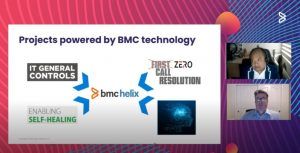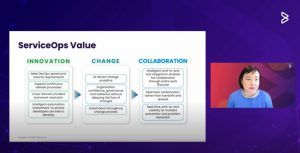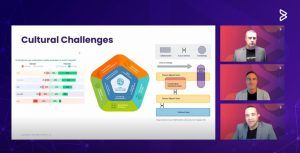In the Autonomous Digital Enterprise (ADE), Enterprise DevOps is a technology-enabled tenet that naturally extends the principles of software DevOps across an organization to optimize for the rapid and continuous delivery of applications and services. At BMC Exchange 2021, we heard from customers and BMC executives about how applying DevOps principles across the enterprise using intelligent automation, artificial intelligence for operations (AIOps), and ServiceOps can lead to new innovations and ultimately kickstart the journey to an ADE.
Intelligent Automation and Innovation
Trung Quach, General Manager of IT Infrastructure and Operations at Videotron, and Dave Schmidt, Director of Solutions Marketing at BMC, chat about how enterprise organizations can adopt intelligent automation to create and deploy innovative services in the session, Solving the Service Paradox: Quality Innovations while Being “Fast and Furious.”
Quach has been a speaker at BMC Exchange for the past few years, so it was great fun to have him back this year to provide some updates on projects at Videotron. Videotron is a telecom company and per Quach, “we offer four services…IP TV, internet at home, we have mobile, and we have home phone. We are around 6,500 employees to make sure that we give the best customer service ever for those services.”
He walked us through four recent projects and the amazing KPIs he was able to achieve using process orchestration, intelligent automation, and AI.

I won’t spoil the ending, but 2.37 times more successful, two times faster, and 42 percent less expensive are just a few of the amazing results he has achieved across these projects.
And the key to his success, he explains, is process. In the ADE tenet of Enterprise DevOps, development and operations teams shift their focus from legacy infrastructure and manual workflows to collaboration, information sharing, and resolving incidents by leveraging AI and automation. “Each time we want to take something and make it better with automation, with data, we always [make] the same mistake,” Quach explains.
“We go in the technology right away, and this is how we fail, right? And then after that, we [realize] there’s something wrong with this. We’re asking [for] more money. But our project is to reduce costs. We were going to create more errors, but our project is to make data better. So, we go down to the process. We always end up starting with technology and end up in the process. And this is how we fix all of it.”
In terms of applying intelligent automation across the enterprise, Quach says, “[With more people] doing technology automation, we focus back on, ‘If you would do it manually, how would you do it in your process?’ And we would automate that process…We can open all the tickets. We can close the tickets, we can double check whatever a human can double check, like you would do it manually. And that’s how now we don’t have incidents on those things.”
Watch the full panel here to hear more about how Videotron has applied intelligent automation to deliver new and innovative services across the business.
ServiceOps
What is ServiceOps? It’s the result of combining AIOps with artificial intelligence for service management (AISM). At BMC Exchange 2021, Margaret Lee, SVP and GM of Digital Service and Operations Management at BMC, explains ServiceOps in her session, How the Combo of AIOps and AISM Can Help You Achieve ServiceOps.
According to Lee, ServiceOps “help teams to innovate, to manage the risk of change, and to collaborate across teams.” Supporting traditional IT and DevOps initiatives, ServiceOps helps organizations improve DevOps processes and increase agility by using AI to predict change risk using service and operational data, support cross-functional collaboration, and automatically recommend problem resolutions.

In applying DevOps across the entire enterprise, Lee explains, “[A lot] of DevOps is driven by the need to innovate, to continue to release and put [out] new capabilities. And also, the innovation is cross-domain. It’s not just the engineering team, there might be product teams, even marketing teams that [are] trying to put new capabilities in the hands of customers. All of this innovation is really driving a lot of change…so in that environment, it is very important to understand the risks associated with change.”
“So, using AI to look at change analytics [gives] organizations confidence, and the ability to govern, to understand which changes are more risky, which changes are safer to proceed, [and] the automation of the processes to apply these changes. ServiceOps enables…seamless collaboration between teams and real-time, end-to-end visibility of what is being applied and how that is materializing in the backend.”
To learn more about ServiceOps, view the full panel, (it’s free to register)!
Enabling SREs with AIOps and AISM
While AIOps and AISM can be used to achieve ServiceOps, they can also help site reliability engineers (SREs) succeed. By leveraging Enterprise DevOps across the enterprise from mainframe to cloud, an SRE drives reliability from a software perspective and ensures stability from an engineering perspective. At BMC Exchange 2021, a session on Enabling SREs with AIOps and AISM was presented by three members of BMC’s CTO Office: Craig Sisson, Greg Bukowski, and Jeremy Hamilton.
Bukowski starts off, “Having that culture of Enterprise DevOps throughout your organization from mainframe to cloud, [is] like a lot of customers I work with. You’ve got your cloud awesome team that goes and does their cool stuff, but how do you share that pervasively throughout your organization? And that’s the challenge. Most of my customers actually call it service reliability, because they’re not doing sites, they’re running business services. And that transformation of the service concept within an organization is fundamentally shifted.”
Hamilton discusses some of the challenges that are facing SREs today, “Toil is all those activities that have to be done to keep the production environment up and running, but really don’t provide any enduring value. And toil comes in all kinds of flavors…Probably the hardest part of tackling toil is identifying it, but once it’s identified, then you can use automation and technology to start to eliminate it all with the goal of spending less than 50 percent of your time doing that kind of work. So, the focus on availability and reliability while eliminating toil from a system that spans multiple platforms and technologies, that’s no easy feat, at least not for humans.”

In using AIOps and AISM to reduce toil and help SREs succeed, Hamilton adds, “If you think about an embedded SRE, [they] span, the entire business service, all the different platforms, all the different pieces. And they may not have extensive mainframe knowledge, at least not from a developmental perspective. And then they’re right in the middle of the problem solving…so it’s important to have…easy-to-use, modern tools…to enable that SRE to take a look at what did happen and why did it happen? And are there ways [to] make sure this doesn’t happen again?”
To view the full panel, click here (it’s free to register)!
To see more of the great conversations from BMC Exchange 2021, visit https://exchange.bmc.com.





